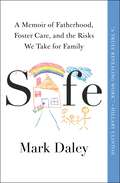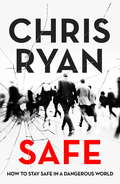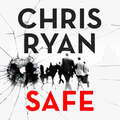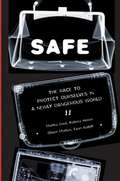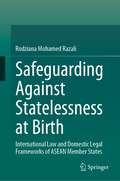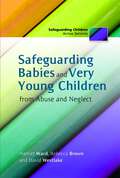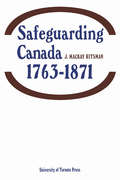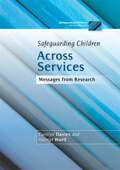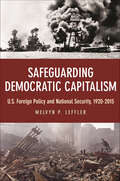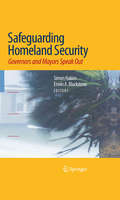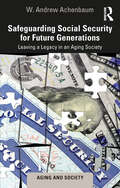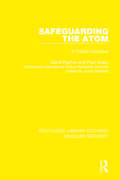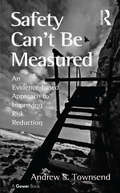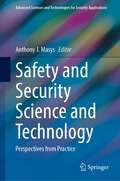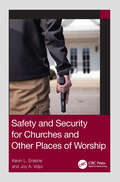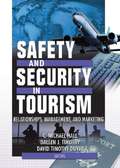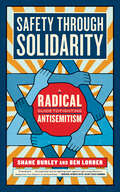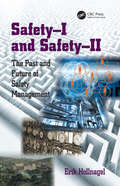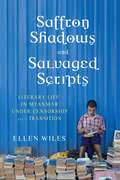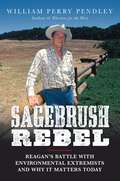- Table View
- List View
Safe: A Memoir of Fatherhood, Foster Care, and the Risks We Take for Family
by Mark DaleyA heartrending and unforgettable memoir of an unlikely journey to parenthood through America&’s broken foster care system.What does it take to keep a child safe? As a long-time strategist and activist fighting for better outcomes for foster children, Mark Daley thought he had the answer. But when Ethan and Logan, an adorable infant and a precocious toddler, entered into their lives, Mark and his husband Jason quickly realized they were not remotely prepared for the uncertainty and complication of foster parenting. Every day seven hundred children enter the foster care system in the United States, and thousands more live on the brink. Safe offers a deeply personal window into what happens when the universal longing for family crashes up against the unique madness and bureaucracy of a child protection system that often fails to consider the needs of the most vulnerable parties of all—the children themselves. Daley takes us on a roller coaster ride as he and Jason grapple with Ethan and Logan&’s potential reunification with their biological family, learn brutal lessons about sacrifice, acceptance, and healing, and face the honest, heartbreaking, and sometimes hilarious challenges of becoming a parent at the intersection of intergenerational trauma, inadequate social support, and systemic issues of prejudice. For fans of Nicole Chung&’s All You Can Ever Know, Stephanie Land&’s Maid, and Roxanna Asgarian&’s We Were Once a Family, this touching and suspenseful memoir highlights the impossible choices all parents, in the foster system and beyond, face in raising children today. Safe shines a much-needed spotlight on how this country treats the most vulnerable among us, sounding a vital call to overhaul a thoroughly broken system.
Safe: Survival techniques for everyday life from an SAS hero
by Chris RyanIn today's increasingly hostile climate people are anxious about how to keep themselves safe. Chris Ryan served in the SAS for seven years and in several war zones throughout the world. During this time he was the Regiment's top striker and in 1991 during the infamous Bravo Two Zero mission behind Iraqi lines he was the only member of the team to evade capture and fight his way to safety, for which he was awarded the Military Medal - his CO said he had 'made Regiment history'. He is the author of bestselling fiction based on his own experiences and is an expert in dangerous situations. Here he tells you how to keep yourself and your family safe from the perils of modern urban life. He leads you through a variety of situations including what to do if:- You are walking down the street and think you are being followed- You find yourself confronted by a threatening group of people or a gang- You find yourself caught in the middle of a riot- You hear gunfire or explosions in a crowed place (e.g. shopping centre)- You hear on the radio that Russia has launched nuclear missiles that will land in the centre of London in two hours.
Safe: Survival techniques for everyday life from an SAS hero
by Chris RyanIn today's increasingly hostile climate people are anxious about how to keep themselves safe. Chris Ryan served in the SAS for seven years and in several war zones throughout the world. During this time he was the Regiment's top striker and in 1991 during the infamous Bravo Two Zero mission behind Iraqi lines he was the only member of the team to evade capture and fight his way to safety, for which he was awarded the Military Medal - his CO said he had 'made Regiment history'. He is the author of bestselling fiction based on his own experiences and is an expert in dangerous situations. Here he tells you how to keep yourself and your family safe from the perils of modern urban life. He leads you through a variety of situations including what to do if:- You are walking down the street and think you are being followed- You find yourself confronted by a threatening group of people or a gang- You find yourself caught in the middle of a riot- You hear gunfire or explosions in a crowed place (e.g. shopping centre)- You hear on the radio that Russia has launched nuclear missiles that will land in the centre of London in two hours.
Safe: Survival techniques for everyday life from an SAS hero
by Chris RyanHow to keep you and yours safe from the perils of the modern world.In today's increasingly hostile climate people are anxious about how to keep themselves safe. Chris Ryan is an expert in dangerous situations and here he tells you how to keep yourself and your family safe from the perils of modern urban life. He leads you through a variety of situations including what to do if:- You are walking down the street and think you are being followed- You find yourself confronted by a threatening group of people or a gang- You find yourself caught in the middle of a riot- You hear gunfire or explosions in a crowed place (eg shopping centre)- You hear on the radio that Russia has launched nuclear missiles that will land in the centre of London in two hours.(P)2017 Hodder & Stoughton Limited
Safe: The Race to Protect Ourselves in a Newly Dangerous World
by Martha Baer Katrina Heron Oliver Morton Evan RatliffJournalists explore the growing role that technology plays in the potential for terrorist attacks. Focuses on the work done by individuals in a variety of technical fields who strive to keep the country safe. Looks at code-breakers, computer scientists, medical researchers, engineers, electronics experts, and more.
Safeguarding Against Statelessness at Birth: International Law and Domestic Legal Frameworks of ASEAN Member States
by Rodziana Mohamed RazaliThis book covers the essential aspects of prevention of childhood statelessness focusing on norms governing the subject through the rights to acquire a nationality and to birth registration, two vital safeguards to prevent statelessness among children. Its unique feature lies in its exposition of the international legal norms focusing on prevention of childhood statelessness and systematic analyses of domestic legal frameworks on nationality and birth registration of the 10 ASEAN Member States. This book is designed for a wide range of readers comprising academics, advocates, students, policy makers, and other stakeholders working on statelessness affecting children, especially in Southeast Asia.
Safeguarding Babies and Very Young Children from Abuse and Neglect
by Rebecca Brown Harriet Ward David WestlakeSafeguarding babies and very young children is a highly complex process, involving difficult decisions surrounding their needs, care, and whether they need to be separated from their families. This book, based on a research study which followed babies who were identified as likely to suffer significant harm before their first birthdays until they were three years old, explores key issues surrounding the safeguarding process. These include how the decision whether to remove children from their families are made, whether social work interventions work and the impact they have on children's life pathways. It also examines the role various participants, including parents, have in decision-making. The findings of the study show a close link between decisions, maltreatment and children's developmental problems, and provide key implications and recommendations for policy and practice. This significant book will be essential reading for all those involved in safeguarding children, including practitioners and policymakers, academics and researchers.
Safeguarding Canada 1763-1871
by J HitsmanCanadian defence policy has been largely neglected by historians except as a problem related to constitutional and political development. Dr. Hitsman repairs this neglect in his study of the military aspects of the defence of Canada, from the British Conquest to the withdrawal of the British garrison. His investigation demolishes a number of myths which have sprung up in this era of Canadian history. For example, in his examination of the military arrangements of the British in Canada Dr. Hitsman points out that, contrary to established belief, Guy Carleton, the last officer of the British Army to hold the appointment of Commander-in-Chief in North America, did more than just muddle through when Americans invaded Canada in 1775. This and many other misconceptions are corrected in this lucid study. After a brief introductory section on the problems of defence and attack during the period of the Conquest, there follows a coherent and intelligent account of the military aspects of Canadian defence after 1760: the geographical factors in strategy, the degree of potential danger, the men and resources available, and the policies pursued by the British government and its agents in Canada. The attitudes and behaviour of both English-speaking and French Canadians are also examined in their relationship to British rule. This book presents the facts about Canadian defence policy from original sources. Basing his study on Admiralty, Colonial and War Office papers, Dr. Hitsman reveals a remarkable ability for finding the appropriate document to illustrate each stage in the development in defence planning. His personal knowledge of army organization and his ability to make his way easily through military reports help to make this study an important contribution to Canadian history and scholarship.
Safeguarding Democratic Capitalism: U.S. Foreign Policy and National Security, 1920–2015
by Melvyn P. LefflerSafeguarding Democratic Capitalism gathers together decades of writing by Melvyn Leffler, one of the most respected historians of American foreign policy, to address important questions about U.S. national security policy from the end of World War I to the global war on terror. Why did the United States withdraw strategically from Europe after World War I and not after World War II? How did World War II reshape Americans’ understanding of their vital interests? What caused the United States to achieve victory in the long Cold War? To what extent did 9/11 transform U.S. national security policy? Is budgetary austerity a fundamental threat to U.S. national interests?Leffler’s wide-ranging essays explain how foreign policy evolved into national security policy. He stresses the competing priorities that forced policymakers to make agonizing trade-offs and illuminates the travails of the policymaking process itself. While assessing the course of U.S. national security policy, he also interrogates the evolution of his own scholarship. Over time, slowly and almost unconsciously, Leffler’s work has married elements of revisionism with realism to form a unique synthesis that uses threat perception as a lens to understand how and why policymakers reconcile the pressures emanating from external dangers and internal priorities.An account of the development of U.S. national security policy by one of its most influential thinkers, Safeguarding Democratic Capitalism includes a substantial new introduction from the author.
Safeguarding Homeland Security
by Erwin A. Blackstone Simon HakimThis book brings together the technological and managerial innovations suggested and applied by the nation's leading governors and mayors in their own words. It includes models for public-private partnerships to improve preparation for, response and recovery from major natural disasters and terrorist attacks. These leaders in innovation point out how the 9/11 communication problems that contributed to the catastrophe have been addressed, including the use of volunteer agencies and volunteers to supplement governmental efforts, which is a recurring theme of the book. The book makes specific recommendations of services usually provided by public emergency agencies that are private in nature and could be shed by government while often being provided by the private sector. The book further suggests public services that are under the responsibility of governments but could be delivered more efficiently by contracting them out under competitive conditions and highlights incentives for greater involvement of the private sector in the delivery of emergency services.
Safeguarding Social Security for Future Generations: Leaving a Legacy in an Aging Society (Aging and Society)
by W. Andrew AchenbaumThis book offers a unique multigenerational approach to saving Social Security. Public programs have adapted to societal aging, but fears overwhelm hopes for Social Security’s future prospects. Conservatives want to privatize operations that liberals seek to expand. Younger workers are happy that Social Security protects their elders, but most do not expect benefits when needed. Achenbaum reframes conflicting perspectives and offers new models of respectful transgenerational dialogue that can mobilize pragmatic reforms. Designed for use in gerontology, social work, and public policy courses, Safeguarding Social Security for Future Generations offers measured hope for leaving a legacy that safeguards the common good.
Safeguarding the Atom: A Critical Appraisal (Routledge Library Editions: Nuclear Security)
by David Fischer Paul SzaszSafeguards play a key role in verifying the effectiveness of restraints on the spread of nuclear weapons. Originally published in 1985, this book is a study of the safeguards system of the International Atomic Energy Agency, an important element of the non-proliferation regime. It breaks new ground by focusing on the politics of safeguards, especially the political problems of the IAEA and of the day-to-day application of safeguards. It contains a critical appraisal and proposals for ways of improving existing procedures, and of adapting them to the political and technological changes of recent years. Safeguarding the Atom gives an analysis of the following questions: What are IAEA safeguards and how do they work? How effective are they? How can they be reinforced? What sanctions can be imposed in the event of non-compliance? IAEA safeguards represent the world's first and so far only attempt to verify an arms control agreement by systematic on-site inspection, and their applicability to other arms control measures is examined.
Safer Homes, Stronger Communities: A Handbook for Reconstructing After Natural Disasters
by Priscilla M. Phelps Daniel Pittet Stephen Sena Jennifer Duyne Barenstein Abhas K. JhaBest practices in post-disaster housing and community reconstruction are constantly evolving. The frequency and severity of disasters are increasing and technology is changing how reconstruction is done. Reconstruction projects must increasingly focus on the need to reduce future risks by ensuring that what is rebuilt is safer and more disaster-resilient than what was there before. The expanding role of communities in managing community reconstruction, with financial and technical assistance from government, is another way reconstruction is changing. 'Safer Homes, Stronger Communities' is a handbook that gives policy makers and project managers the information they need to plan and carry out housing and community reconstruction projects that empower communities affected by disasters and that reduce their vulnerability to future disasters. The handbook includes nearly 100 case studies collected from global experts with recent experience in housing reconstruction that illustrate how the policies and practical approaches recommended in the handbook have been used on the ground. It also includes links to extensive technical information on the topics covered by the handbook and is complemented by a Web site for practitioners in the field (http://www.housingreconstruction.org). Designed to provide immediate guidance in post-disaster reconstruction settings, 'Safer Homes, Stronger Communities' is a vital resource for policy makers and project managers, and for all practitioners involved in post-disaster housing and community reconstruction and disaster risk management.
Safety Can't Be Measured: An Evidence-based Approach to Improving Risk Reduction
by Andrew S. TownsendThe British Prime Minister has avowed to ’kill off the health and safety culture’ which he described as ’a monster’. Nonetheless, industries face ever increasing public expectation and legislative pressure to improve safety when, actually, rates of safety improvement have slowed to a standstill. In Safety Can't Be Measured, Andrew Townsend suggests the main reason for the stagnation of safety improvement is the failure to recognise the evolution in accident causation and to evolve with it. He severely criticises some aspects of current day management of occupational safety and contends that everyone is trying to continuously improve something in which improvement cannot be measured, so the received wisdom underpinning safety management and regulation is not evidence-based and much of it is misguided. What is measured is the absence of safety - through incidents, injuries and the occurrence of ill health. We cannot continue to justify these ways of doing things, and claiming success by association, without admitting there might be other explanations. In this series of short chapters, occupational health and safety is put in context by demystifying the research, regulation and management of health and safety. Using evidence, Townsend challenges orthodox dogma by demonstrating that currently unused data could help deduce how safety really works, and thus support alternative thought processes from which new approaches to risk reduction and safety management could emerge.
Safety and Security Science and Technology: Perspectives from Practice (Advanced Sciences and Technologies for Security Applications)
by Anthony J. MasysGlobal security threats have created a complex risk landscape that is challenging and transforming society. These global security issues intersect and influence the political, economic, social, technological, ecological and legal dimensions of the complex risk landscape and are now transborder thereby becoming national security issues. Accessing the innovation space to support safety, security and defence capabilities is critical in order to mitigate new and evolving threats.Through real-world examples of innovation, this book provides a detailed examination of the innovation space as it pertains to the application of S&T to safety and security threats and challenges. This book is of most interest to public and private sector innovators as well as academician and graduate students working in the safety and security domain.
Safety and Security for Churches and Other Places of Worship
by Kevin L. Erskine Joy A. VolpiSafety and Security for Churches and Other Places of Worship is a reference book focused on how to form a first responder team for churches, synagogues, temples, and other places of worship. It will assist team leaders on how to train for both security and medical emergencies, provide training aids and ideas, and how to write SOPs and legal issues. Trending violence directed at soft targets is growing, forcing places of worship to respond with highly trained personnel to quickly intervene. Many medical incidents can have drastically better outcomes if trained medical personnel render immediate medical care. For instance, the use of an AED in conjunction with CPR can drastically improve survival rates from 15% to 85%, versus just CPR alone. Topics covered include: Environmental disasters Acts of violence Active shooter incidents Bomb threats Unruly/disruptive persons Suspect control Sexual abuse Realistic training using fake wounds Tabletop exercises Team building Medical emergencies An equipment chapter helps to determine what equipment is a priority for teams limited by budget. Some equipment can mean the difference between a "friend" being mistaken for an aggressor, resulting in an innocent person being injured or killed. Safety and Security for Churches and Other Places of Worship is a must-have reference for anyone charged with the duty to protect those who attend and work at places of worship.
Safety and Security in Tourism: Relationships, Management, and Marketing
by Dallen J. Timothy David Timothy Duval C Michael HallHow will the travel and tourism industry respond to the terrorist attacks on America?The recent terrorist attacks in the United States and their repercussions for the travel and leisure industries have focused more attention on tourism safety and security issues than ever before. The impact on tourism destinations and businesses, as well as on traveler behavior, will be significant. Recent events require further analysis not only of how travel safety may be improved but also how security issues may be seen in terms of tourism marketing and management so that the industry is able to better respond to such challenges.In this, an era of turbulent global relationships, the need for destination marketing organizations to demonstrate that they are safe for tourists has become increasingly important. Negative publicity, often unrelated to on-the-ground reality, may also serve to affect tourist perceptions.Safety and Security in Tourism: Relationships, Management, and Marketing examines: the effects of the September 11, 2001 attacks on the tourism industry and how the industry is responding the importance of safety as a factor in destination or activity choice case studies of destination and business responses to past political instability and/or attacks against tourists safety, security and destination image the role of the media in influencing consumer perceptions of travel safety consumer awareness of travel advisories and their influence on behavior the role of insurance in the travel industry consumer awareness and acceptance of security measures in travel and tourism safety and security as a component in destination marketing crisis and risk management in the tourism industry cross-border security and visa controls and their implications for tourism safety and security measures for tourists in different sectors and in airportsTourism has often been cited as a force for peace, yet tourism is typically one of the first industrial casualties of war and political unrest. This book examines tourism safety and security issues to give you a better knowledge base from which to respond to future events.
Safety through Solidarity: A Radical Guide to Fighting Antisemitism (Activist Citizens' Library)
by Shane Burley Ben LorberTwo activist journalists present a progressive, intersectional approach to the vital question: What can we do about antisemitism?Antisemitism is on the rise today. From synagogue shootings by white nationalists, to right-wing politicians and media figures pushing George Soros conspiracy theories, it&’s clear that exclusionary nationalist movements are growing. By spreading division and fear, they put Jews, along with other marginalized groups and multiracial democracy itself, at risk.And since the outbreak of war in Gaza, debates around antisemitism have become more polarized and high-stakes than ever. How can we stand in solidarity with Palestinians seeking justice, while also avoiding antisemitism — and resisting those who seek to conflate the two? How do we forge the coalitions across communities that we need, in order to overcome the politics of division and fear?Using personal stories, historical deep-dives, front-line reporting, and interviews with leading change-makers, Burley and Lorber help us break the current impasse to understand how antisemitism works, what&’s missing in contemporary debates, and how to build true safety through solidarity, for Jews and all people.
Safety-I and Safety-II: The Past and Future of Safety Management
by Erik HollnagelSafety has traditionally been defined as a condition where the number of adverse outcomes was as low as possible (Safety-I). From a Safety-I perspective, the purpose of safety management is to make sure that the number of accidents and incidents is kept as low as possible, or as low as is reasonably practicable. This means that safety management must start from the manifestations of the absence of safety and that - paradoxically - safety is measured by counting the number of cases where it fails rather than by the number of cases where it succeeds. This unavoidably leads to a reactive approach based on responding to what goes wrong or what is identified as a risk - as something that could go wrong. Focusing on what goes right, rather than on what goes wrong, changes the definition of safety from ’avoiding that something goes wrong’ to ’ensuring that everything goes right’. More precisely, Safety-II is the ability to succeed under varying conditions, so that the number of intended and acceptable outcomes is as high as possible. From a Safety-II perspective, the purpose of safety management is to ensure that as much as possible goes right, in the sense that everyday work achieves its objectives. This means that safety is managed by what it achieves (successes, things that go right), and that likewise it is measured by counting the number of cases where things go right. In order to do this, safety management cannot only be reactive, it must also be proactive. But it must be proactive with regard to how actions succeed, to everyday acceptable performance, rather than with regard to how they can fail, as traditional risk analysis does. This book analyses and explains the principles behind both approaches and uses this to consider the past and future of safety management practices. The analysis makes use of common examples and cases from domains such as aviation, nuclear power production, process management and health care. The final chapters explain the theoret
Saffron Shadows and Salvaged Scripts
by Ellen WilesUntil 2012, Myanmar had been ruled for fifty years by one of the most paranoid and repressive censorship regimes in history. The military junta enforced strict reading and writing restrictions in line with their socialist ideology and was terrified of writers who could trigger change.Transition has lifted the worst restrictions, initiating a new era in the country's literature and literary culture. Inspired by Ellen Wiles's hunt for contemporary writing while living in Myanmar in 2013, this book explores the experiences and recent output of nine Myanmar writers spanning three generations, featuring interviews and English-language translations of their work, along with political, legal, and artistic analyses. Wiles includes men and women, fiction and poetry, capturing the effects of political and cultural change as they rippled across different groups and genres. Her work contributes both to the general study of art under censorship and beyond to Myanmar's democratic renaissance.
Saffron Shadows and Salvaged Scripts: Literary Life in Myanmar Under Censorship and in Transition
by Ellen WilesThis book tells an ethnographic story of a secret literary culture that has recently emerged from its cocoon. Until 2012, Myanmar (also known as Burma) was ruled for fifty years by one of the most paranoid and repressive censorship regimes in history. The military junta enforced strict reading and writing restrictions in line with their ideology, feared writers' potential to trigger change, and did their best to keep Western books and influences out of the country. As part of an unexpected move toward democracy, the government has recently lifted the worst restrictions on reading and writing, giving rise to a new era in the country's literature and literary culture. While living in Myanmar in 2013, Ellen Wiles sought out the best of its contemporary writers and writing to begin uncovering the country's remarkable literary life and history. This book contains the experiences and recent output of nine Myanmar writers spanning three generations, featuring interviews and English-language translations of their work, along with political, legal, and artistic explorations. It includes men and women, fiction and poetry, reflecting the ripples of political and cultural change as they have moved across different groups and genres. A rare portrait of a people and place in transition, Wiles's work contributes both to the study of literature and culture in Myanmar and to the general study of art under censorship.
Safire's New Political Dictionary
by William SafireSafire's definitions-- discursive, historically aware, anecdotal-- bring a savvy perspective to our colorful political lingo. It reads like a mini-essay in political history, and readers will come away with a fuller understanding of particular words.
Sagebrush Rebel: Reagan's Battle with Environmental Extremists and Why It Matters Today
by William Perry PendleyThe fascinating story of how Ronald Reagan, self-proclaimed "sagebrush rebel," took his revolutionary energy policies to Washington and revitalized the American economy.Governor Reagan, with his unbridled faith in American ingenuity, creativity, and know-how and his confidence in the free-enterprise system, believed the United States would "transcend" the Soviet Union. To do so, however, President Reagan had to revive and revitalize an American economy reeling from a double-digit trifecta (unemployment, inflation, and interest rates), and he knew the economy could not grow without reliable sources of energy that America had in abundance.The environmental movement was in its ascendancy and had persuaded Congress to enact a series of well-intentioned laws that posed threats of great mischief in the hands of covetous bureaucrats, radical groups, and activist judges. A conservationist and an environmentalist, Ronald Reagan believed in being a good steward. More than anything else, however, he believed in people; specifically, for him, people were part of the ecology as well. That was where the split developed.William Perry Pendley, a former member of the Reagan administration and author of some of Reagan's most sensible energy and environmental policies, tells the gripping story of how Reagan fought the new wave of anti-human environmentalists and managed to enact laws that protected nature while promoting the prosperity and freedom of man-saving the American economy in the process.
Saha: The new novel from the author of Kim Jiyoung, Born 1982
by Cho Nam-JooIn a country called ‘Town’, Su is found dead in an abandoned car. The suspected killer is presumed to come from the Saha Estates. <p><p> Town is a privatised country, controlled by a secretive organisation known as the Seven Premiers. It is a society clearly divided into the haves and have-nots and those who have the very least live on the Saha Estates. Among their number is Jin-Kyung, a young woman whose brother, Dok-yung, was in a relationship with Su and quickly becomes the police’s prime suspect. <p><p> When Dok-yung disappears, Jin Ky-ung is determined to get to the bottom of things. On her quest to find the truth, though, she will uncover a reality far darker and crimes far greater than she could ever have imagined. At once a dystopian mystery and devastating critique of how we live now, Saha lifts the lid on corruption, exploitation and government oppression, while, with deep humanity and compassion, showing us the lives of those who, through no fault of their own, suffer at the hand of brutal forces far beyond their control.
